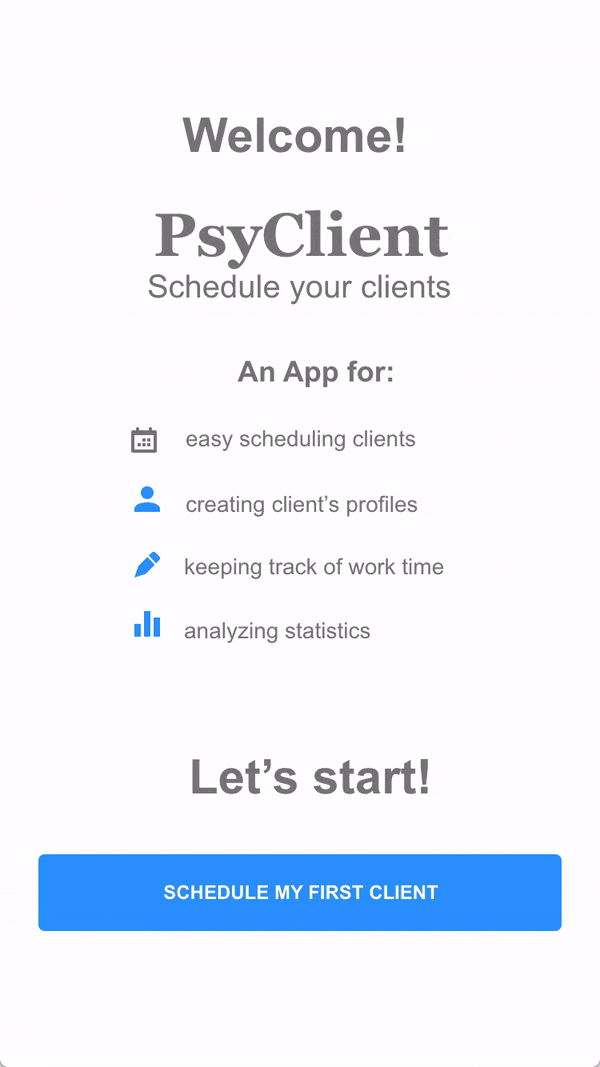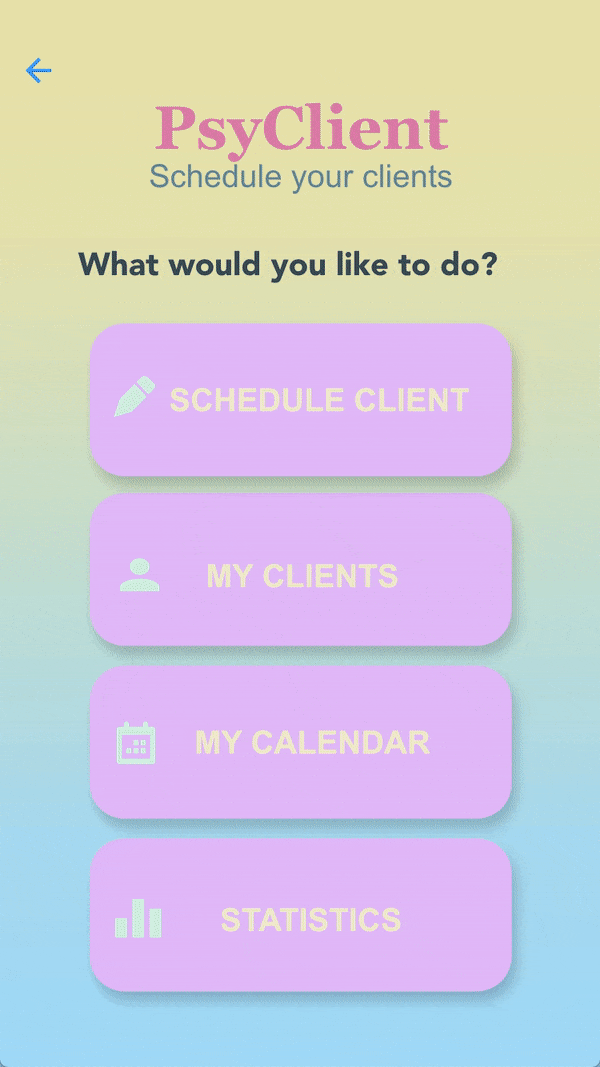Process for the Project

Project Background
Many mental health counsellors and coaches work as self-employed professionals. They have a lot of work activities that take up their time - professional conferences, additional education, writing case reports. In addition to all that they need to do all the planning work by themselves — decide where to find clients, how to attract them, plan the sessions schedule and remember all their clients' stories.
It could get very overwhelming and coaches tend to keep their notes in lots of places, feeling insecure about their work stability and find it hard to plan several months ahead.
Research Question
How can we help coaches feel more confident and comfortable when planning their work and save their precious time?
Solution
App prototype that will help counsellors and coaches in:
-
Work schedule planning
-
Workload analysis
-
Getting insights about clients and topics in demand
User Research
I've conducted 6 interviews (3 coaches and 3 mental health counsellors), each for around 1 hour long.

Examples of user interview questions
First insights from interviews:
-
Counsellors and coaches love their work with clients but are frustrated when it comes to all the planning and organizing appointments
-
They use lots of tools for planning, often several at once — Calendars in smartphones, notes in smartphones, notebooks, sticker notes, calendar on the wall
-
Most of the booking happens through phone calls or emails
-
Most of them have a vague idea of how clients find them and try to advertise on lots of platforms
-
They usually plan only for the next week-month, so feel unsure about the long term plans and income
Pain points discovered:
-
The planning process seems to be a pain point and there are many ways they currently use to solve it (like calendars, notepads, notes in smartphones, stickers, excel sheets etc.) but it still creates some confusion and frustration.
-
As a consequence of the first pain point — it is difficult to analyze the scope of practice looking back and many just don’t do it. They trust their gut feeling if they have enough clients or not, but that may lead to less confidence.
Competitor Analysis
After classifying all the features that coaches already use or would like to have, I’ve defined 11 key metrics for this analysis and looked if Apps had the following options:

Comparing 9 planning Apps for self-employed professionals on the Russian market at that time
(each metric is rated on a 0-3 scale)
User Personas
The next step was to pull together all the findings from the interviews and create User Personas, that would reflect the major goals and frustrations of my possible users and describe their current work process.

One of the Personas - “Successful Paul”
Storyboarding
When I had Personas in front of my eyes it was time to imagine how exactly they would interact with my App.


Storyboard 1 when Paul receives a message from a client and schedule her in the App
Storyboard 2 where Paul schedule the next session and add some comments and a photo of learning materials
Information Architecture
I started to plan what screens would be in my App and what questions could my users possibly have on each of these screens. It helped me understand on the high level what features I will include on each screen and have a user flow could look like.

Main User flow and user's questions on each step
Wireframes
To see how clear and logical users see my App structure I draw some low-fidelity wireframes and test them with 3 users.
1st screen - Schedule client: during testing users felt nervous that are offered to schedule the client as a first step without understanding what this App is about.
2d screen - Calendar: some users felt confused that they should start with choosing the time and not with fill in the client info first.
3d screen - Client card: users wanted to enter more information to the card, like topics, place, type of consultation.
4th screen - Calendar with booking: overall users felt ok with it, but all of them were wondering about the next steps: how to look for the info, how to edit it if needed etc.
The overall feedback: “It doesn’t seem so different from what I’m doing now with the Calendar in my phone, so what’s the value?” So I needed to make sure my idea would address the pain points more directly and solve the specif problems so users see the value.

Wireframes v1.

Wireframes v.2 after the testing
Prototyping
I created a prototype with 22 main screens for future testing in 2 languages: prototypes in Russian (in Axure) and prrototype in English (in AdobeXD).


Example of prototype screens and interaction flow
Usability Testing
To see how the users will interact with the prototype and find out about the issues and challenges they experience while using the App I have created 5 scenarios for the testing.
Scenario 1
Task: Schedule a new client
Legend: You want to try new App and schedule a client Olga Orlova for 5th October 12 pm this week. She wants to talk about relationships with her daughter. You would also like to receive a reminder an hour before.
Scenario 2
Task: Look up statistics for sessions formats
Legend: You’ve been already scheduling clients in the App for several months and want to understand which format — Skype or in person — is more popular with your clients.
Scenario 3
Task: Look up information about a client
Legend: Your former client Elena N. wants to schedule a new session after a long break and you don’t remember clearly what were the topics of your work and how long did you work with her. Please find the information about her.
Scenario 4
Task: Look up statistics for popular topics
Legend: You’d like to give new advertising for your practice and you want to understand what topics are the most common among your clients so you can mention it in an add.

Usability Testing results
Scenario 5
Task: Schedule an existing client
Legend: Your existing client Igor P. has just sent you a message asking to schedule to schedule his next session on October 6th 11 am.
Main Findings
-
Scheduling existing clients turned out to be confusing for some users as there were 2 ways to do it — going through “Calendar” or through “My clients”
-
Some users wanted to be able to filter statistics according to time periods (weeks/months/years) for better analysis
-
Some users felt profiles required too much information to fill in
-
Some users wanted to add scheduled sessions time to the client card
-
Some users wanted times slots to be highlighted in different colours according to types of session/format to instantly get the whole picture
Final Designs

Prototype screens in colour

Interaction animation
Key Learnings
-
During the first stage of user research, I was relying only on the interviews and not doing an observation method to see how they really do it. I discovered much later in the process that users often don’t remember clearly how they do things and miss out on many details — so I would definitely include it.
-
During Market Research I was seeing only other Apps as competitors, when in fact all the ways they are doing planning now are the competitors as well including notebooks, pads and sticker notes. I would now think about it through Jobs to be done approach.
-
Context always matters! In Russia, both mental health counsellors and coaches are non-licensed professions and they don’t have any legal obligation about client data protection (sad, but true). Since I came to Canada I've learnt that here counsellors need to keep all their client information confidential in the safe and use only approved online work tools. So obviously my whole idea about client card wouldn’t work here and I would approach it totally different.


